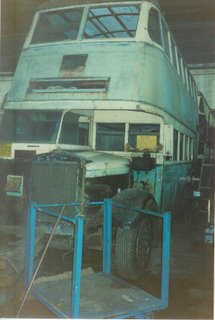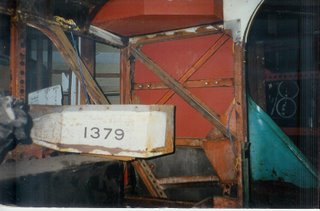When I was young, four years old, my parents moved to Canberra. This was a bit of a culture shock for me – I had grown up with trams, steam ferries, double deckers, electric trains, steam trains of all sorts, and all the sights and sounds of Sydney Harbour. Canberra had the muddy, weedy Molonglo River and some boring AEC Regal half cabs.
One Grandmother lived at Northbridge, on Sailors Bay Road, so staying there in school holidays meant TD4s and TD5s taking off outside the front door on route 207. I thought they sounded rather special. When the chance came many years later to join a syndicate at Tempe which owned a TD4, fleet no. 1379 in its final days, I jumped at it. My Albion CX19, no. 1892, was largely restored, except for returning the interior to bus configuration, so I felt able to take on a new challenge.

ALBION 1892, NOT THE LEYLAND. WORK PROCEEDS ON THE INTERIOR DURING 1993/5 TO RESTORE IT FROM MOBILE HOME USE TO BUS CONFIGURATION
Fleet number 379, a 1936 Leyland Titan TD4, was bodied by Waddingtons Ltd. at their Camperdown works on Pyrmont Bridge Road. It was ready for the road on 29 June 1937 (officially it entered service on 30 June), and was registered m/o 1579. This was 1200 above its fleet number, a disparity soon to be remedied. In fact an AEC Regent was carrying the m/o 1579 plate by 1939, the latter vehicle having also been bodied by Waddingtons, but at their new Granville works. Just prior to this, Leyland m/o 1579 became m/o 1379, and fleet number 1379, which it carried until its withdrawal in 1963. I am assuming that it was overhauled in 1943, after the mania for camouflage painting had subsided, when it received the simplified red and cream livery, with broad black bands and no lining-out of the body swaging. In about 1948 at its next overhaul it received the post war green and cream, with the same broad black bands, and on 15 December 1953 (fifty three years ago now!) it received the green and cream with narrow black bands, this time picking out the upper of the two swaged lines on each deck.

AT YEOVAL NSW, SHOWING THE VERY FADED COLOURS OF THE 1953 PAINT JOB. THE SHOT ALSO SHOWS THE EARTH BANK WHICH I SUSPECT DID THE REAR PLATFORM NO GOOD AT ALL photo Brian Mantle
Remnants of all these four colour schemes became visible on various body parts during restoration. The restoration is to take it back to 1937 condition, so it is no longer ‘1379’. It will probably be known as 379 or m/o 1579.
Restoration began in 1990, after the bus was towed back from Yeoval, first to Kellyville, where the HCVA had a storage yard, and then to Tempe Tram Sheds when the Association was granted its lease in 1986.

A CHARACTERISTIC OF THE PRE-WAR BUSES WAS THE PAINTED-ON FRONT NUMBER 'PLATE'. THE BUS SITS IN THE WORKSHOP AREA AT TEMPE IN AS-FOUND CONDITION. DAVID WILSON HAS UNEARTHED A BETTER RADIATOR FOR IT.
The syndicate of owners expanded from David Wilson and Brian Mantle to myself plus my son Gwilym, then only 7 years old, and my friends Peter and Kathy Howick. Peter’s distinction is to have been one of ‘Overland Five’ who drove a Bristol K6G ex-Wilts and Dorset Traction, with Eastern Coachworks body, to Australia via Turkey, Afghanistan, Bombay, Perth and Sydney in 1971. (That bus by the way survives in tourist service at Taupo New Zealand).
The first stage of restoration was to remove every panel, window and trim to permit repair of the frame. The rear platform had been crushed by being reversed into the bank a bit too enthusiastically at the Yeoval property. Other areas, especially the cantilever beams over the engine bay and cab, were clearly badly rusted. After the work done on Albion 1892 in the early 1980s, none of this seemed too hard.

AT TEMPE BUS MUSEUM IN 1990 WITH ALL PANELS REMOVED AND WORK ABOUT TO BEGIN ON THE BACK PLATFORM AND STAIRCASE. THE RUST CAN BE SEEN IN THE CANT RAILS OVER THE ENGINE BAY AND IN THE SILLS UPSTAIRS
In early 1990 I enrolled at Hornsby TAFE for a MIG welding course, and soon after bought a DueMig welder for $500. It has been fantastic, and will weld anything from less than 0.5 mm up to 10 mm or more. The four of us, Peter, Kathy, Gwilym and I put in many hours at Tempe, removing all the panels and trims and labelling them, stripping paint from the top deck ceiling, and rebuilding the rear platform with new framing and a new floor of recycled cypress pine tongued and grooved boards. The staircase was renewed from top to bottom, as well as some of its supporting frame, and a new pan made for the top step where it protrudes into the bottom deck roof. An entire new skirt rail was fitted from front to rear on the near side top deck, also along the bottom of the lower deck on each side.

THE PAN FOR THE TOP STEP IN PLACE WITH THE ORIGINAL BELOW IT

THE TOP STEP FROM INSIDE THE STAIRWELL. IT IS A NATURAL TRAP FOR WATER, AS THE WOODEN STAIR TREAD HOLDS RAIN DROPS, FROM THE WINDOWS ABOVE, AGAINST THE STEEL
And then in August 1993, things went a bit quiet. Although Gwilym and I did a few things to finish off the staircase in early 1994, Peter and Kathy moved on to other interests, and I undertook the restoration of the interior of my Albion ex-m/o 1892 back to 1966 condition. It re-entered Museum service as a bus for Motorfest 1996, the first time it had carried ‘fare paying’ passengers since 1970, and after twenty-two years as the family’s private mobile home. This enabled it to be moved from Turramurra to Tempe, thus leaving space for 1379. ‘Fast Eddie’ towed it to Turramurra with poor old Gwilym (aged 15) in the cab holding on for grim death. A few more dents appeared in the roof as the bus was manoeuvred in reverse down the drive at 333 Bobbin Head Road, into the garage where it now resides. At last quality restoration time could be put into the project.
The logical plan was to repair the framing by working from the top down, and from the rear forwards. There is a reason for this. Say the frame in a certain area is rusted in the top deck and in the bottom deck area below it. If you cut out the defective bottom deck members, the weakened top deck may collapse into it, thus destroying certain vital alignments and dimensions. Acting on this theory I started off by making a new upstairs rear emergency window. The old one was hanging off and a complete ruin, and at that stage in decker design there were many variations in that window so finding another one was unlikely.
No comments:
Post a Comment